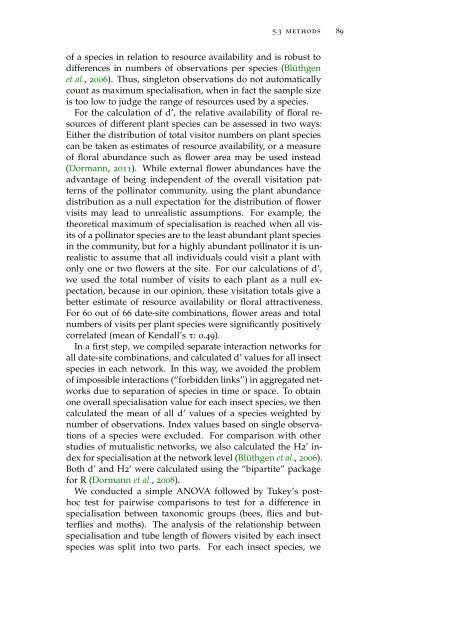Linking Specialisation and Stability of Plant ... - OPUS Würzburg
Linking Specialisation and Stability of Plant ... - OPUS Würzburg
Linking Specialisation and Stability of Plant ... - OPUS Würzburg
Create successful ePaper yourself
Turn your PDF publications into a flip-book with our unique Google optimized e-Paper software.
5.3 methods 89<br />
<strong>of</strong> a species in relation to resource availability <strong>and</strong> is robust to<br />
differences in numbers <strong>of</strong> observations per species (Blüthgen<br />
et al., 2006). Thus, singleton observations do not automatically<br />
count as maximum specialisation, when in fact the sample size<br />
is too low to judge the range <strong>of</strong> resources used by a species.<br />
For the calculation <strong>of</strong> d’, the relative availability <strong>of</strong> floral resources<br />
<strong>of</strong> different plant species can be assessed in two ways:<br />
Either the distribution <strong>of</strong> total visitor numbers on plant species<br />
can be taken as estimates <strong>of</strong> resource availability, or a measure<br />
<strong>of</strong> floral abundance such as flower area may be used instead<br />
(Dormann, 2011). While external flower abundances have the<br />
advantage <strong>of</strong> being independent <strong>of</strong> the overall visitation patterns<br />
<strong>of</strong> the pollinator community, using the plant abundance<br />
distribution as a null expectation for the distribution <strong>of</strong> flower<br />
visits may lead to unrealistic assumptions. For example, the<br />
theoretical maximum <strong>of</strong> specialisation is reached when all visits<br />
<strong>of</strong> a pollinator species are to the least abundant plant species<br />
in the community, but for a highly abundant pollinator it is unrealistic<br />
to assume that all individuals could visit a plant with<br />
only one or two flowers at the site. For our calculations <strong>of</strong> d’,<br />
we used the total number <strong>of</strong> visits to each plant as a null expectation,<br />
because in our opinion, these visitation totals give a<br />
better estimate <strong>of</strong> resource availability or floral attractiveness.<br />
For 60 out <strong>of</strong> 66 date-site combinations, flower areas <strong>and</strong> total<br />
numbers <strong>of</strong> visits per plant species were significantly positively<br />
correlated (mean <strong>of</strong> Kendall’s τ: 0.49).<br />
In a first step, we compiled separate interaction networks for<br />
all date-site combinations, <strong>and</strong> calculated d’ values for all insect<br />
species in each network. In this way, we avoided the problem<br />
<strong>of</strong> impossible interactions (“forbidden links”) in aggregated networks<br />
due to separation <strong>of</strong> species in time or space. To obtain<br />
one overall specialisation value for each insect species, we then<br />
calculated the mean <strong>of</strong> all d’ values <strong>of</strong> a species weighted by<br />
number <strong>of</strong> observations. Index values based on single observations<br />
<strong>of</strong> a species were excluded. For comparison with other<br />
studies <strong>of</strong> mutualistic networks, we also calculated the H2’ index<br />
for specialisation at the network level (Blüthgen et al., 2006).<br />
Both d’ <strong>and</strong> H2’ were calculated using the “bipartite” package<br />
for R (Dormann et al., 2008).<br />
We conducted a simple ANOVA followed by Tukey’s posthoc<br />
test for pairwise comparisons to test for a difference in<br />
specialisation between taxonomic groups (bees, flies <strong>and</strong> butterflies<br />
<strong>and</strong> moths). The analysis <strong>of</strong> the relationship between<br />
specialisation <strong>and</strong> tube length <strong>of</strong> flowers visited by each insect<br />
species was split into two parts. For each insect species, we
















